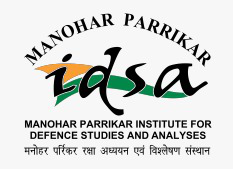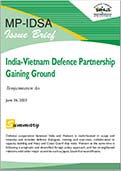India-Vietnam Defence Partnership Gaining Ground
Summary
Defence cooperation between India and Vietnam is multi-faceted in scope and intensity and includes defence dialogues, training and exercises, collaboration in capacity building and Navy and Coast Guard ship visits. Vietnam at the same time is following a pragmatic and diversified foreign policy approach, and has strengthened relations with other major countries such as Japan, South Korea and Russia.
Vietnam’s Minister of National Defence General Phan Van Giang held talks with Defence Minister Rajnath Singh on 19 June 2023. Both sides reviewed the progress on various bilateral defence cooperation initiatives and expressed satisfaction at the ongoing engagements.1 The two-day visit of Gen Giang comes amidst reports that India may be considering to sell the BrahMos missiles to Vietnam, with the value of the deal estimated at $625 million.2 Vietnam has shown interest in acquiring BrahMos in order to help strengthen its coastal defence operations. The Defence Minister of Vietnam also visited DRDO headquarters and discussed ways to enhance defence industrial capabilities by enhancing cooperation in defence research and joint production.3 The regular military exchanges and high-level visits between India and Vietnam reflects the deepening in the partnership which has evolved as a consequence of the rapidly changing regional security dynamics.
Towards a Comprehensive Defence Partnership
The growing trajectory of the India-Vietnam defence cooperation has continued through the Strategic Partnership established in 2007 which was elevated to the level of the Comprehensive Strategic Partnership (CSP) in September 2016. Defence and security cooperation between India and Vietnam has emerged as a key component under the CSP, with both sides emphasising on the need to further enhance existing areas of collaboration. India-Vietnam collaboration in the defence sector began in 1994 with the signing of the first Memorandum of Understanding (MoU) on defence cooperation. It was followed by a formal Defence Protocol in March 2000 where both nations agreed for joint military exercises, joint campaigns on anti-piracy in the South China Sea (SCS) and anti-insurgency training.
In 2003, a Joint Declaration was signed which binds both nations to conduct periodic high-ranking visits and pledged expansion of cooperation in the defence and security spheres. The signing of the MoU on Defence Cooperation in November 2009 has helped build closer interactions, through regular defence dialogue, training, exercises, and Navy and Coast Guard ship visits, along with capacity building.4 Since the establishment of Strategic Partnership and the CSP, there has been progress in the bilateral defence cooperation that included exchange of high-level visits with the first India-Vietnam Security Dialogue taking place in July 2018.5
The India-Vietnam Joint Vision for Peace, Prosperity, and People announced in December 2020 is significant as it serves as the cornerstone for a new era in the bilateral defence partnership. In terms of defence and security cooperation, key agreements include implementing arrangements on defence industry cooperation, increased frequency/regular high-level and institutionalised exchanges aimed at enhancing the security partnership to help maintain and promote stability in the Indo-Pacific.6
During an online interaction between Rajnath Singh and Gen Phan Van Giang of the Ministry of National Defence of Vietnam on 1 July 2021, both sides expressed commitments to further enhance cooperation in defence industry and technology domain under the framework of the Joint Vision Statement of 2020. On 8 June 2022, during the visit of Minister Singh to Vietnam, both sides signed the ‘Joint Vision Statement on India-Vietnam Defence Partnership towards 2030’. A MoU on Mutual Logistics Support was also singed during that visit.7 The MoU was the first such agreement signed by Vietnam with any other country. This would help simplify the procedure of acquiring logistical equipment and support between the two nations.8
Defence cooperation between India and Vietnam is multi-faceted in its scope and intensity that includes wide-ranging contacts between the services, through closer interaction and regular defence dialogues, training and exercises, collaboration in capacity building and Navy and Coast Guard ship visits. In February 2016, for the first time, a Vietnamese ship participated in the International Fleet Review at Vishakhapatnam. In December 2020, the Indian Navy took part in the ‘passage exercise’ (PASSEX) with the Vietnamese Navy in the SCS as part of efforts to boost maritime cooperation between the two countries.
Two Indian Naval Ships, INS Shivalik and INS Kamorta paid port calls to Ho Chi Minh City Port in November 2022 and INS Delhi and INS Satpura made a port call at Da Nang Port from 19-22 May 2023. The gifting of the indigenously-built in-service missile corvette INS Kirpan, during the recent visit of the General Phan Van Gang would enhance the capabilities of the Vietnam People’s Navy.9 Apart from conventional security, the two nations are also enhancing cooperation in the non-traditional security domain in the area of counter-terrorism, transnational organised crimes, and disaster management and response.
Geo-Political Context
The November 1991 Sino-Vietnamese Summit, which normalised relations between the two countries, was driven at least in part by ideology as well as more pragmatic considerations. Over the years, Vietnam has built close political, economic, military as well as cultural ties with China. Although Vietnam has been able to resolve most of its land border disputes with China, the mutual confidence between the two countries has not been fully restored.10 This is as a consequence of the ongoing divergences between Vietnam and China regarding sovereignty in the East Sea/ South China Sea that still remains unsettled.
While Vietnam’s relations with China since the normalisation has matured and grown, there remains a shared mistrust that makes the relationship complex.11 Vietnam has a 2,000-mile coastline facing the East Sea/SCS with significant contribution from the marine economic sector to its GDP. The ongoing maritime dispute thus becomes critical in terms of Vietnam’s geo-strategic thinking with Vietnam prioritising the protection of maritime sovereignty and the maritime economy as a key national security pillar.12
Since 2010, sovereignty disputes in the SCS have intensified with rise in the number of standoffs that includes low intensity engagements such as firing at fishing vessels by the navies of some of the claimants. Further, China’s unilateral action to increase its military presence in the region includes construction of new military bases in the SCS. This poses a major challenge as it impacts regional peace and stability while also having environmental consequences.13
Vietnam remains one of the most strident voices in Southeast Asia against China’s unilateral actions in the SCS. According to China’s self-declared maritime boundary – the ‘nine-dash line’ – the Paracel and the Spratly islands fall within its maritime boundary. Four Southeast Asian countries – Brunei, Malaysia, the Philippines, and Vietnam, are involved in the SCS territorial and maritime boundary disputes with China. Malaysia and the Philippines claim jurisdiction over some of the Spratly Islands while Brunei claims jurisdiction over the centre on the Louisa Reef in the Spratly. The dispute between China and Vietnam in the SCS is over the Paracel and the Spratly islands. Vietnam continues to emphasis on maintaining stability in the SCS, and complying with international law, including the 1982 United Nations Convention on the Law of the Sea (UNCLOS) to which both countries are signatories. 14
The contestation over the demarcation of maritime borders in the SCS in recent years has witnessed China’s unswerving sovereignty claims supported by its ongoing military modernisation and growing economic clout.15 These factors have escalated tensions between the two countries with China sending more ships to Vietnam’s exclusive economic zone (EEZ). The presence of Chinese research, coast guard, and civilian ships in the SCS, sailing through sensitive locations within Vietnamese waters, has been increasing and causing tensions.16
Vietnam acknowledges that the prevailing geo-economic, geo-political and geo-strategic tensions are exerting immense pressure on regional stability and peace. The great power rivalry in the region has further influenced and intensified the ongoing traditional and non-traditional challenges being faced by the region. In this regard, disputes over territorial sovereignty in the SCS has become more complex, which could potentially lead to conflicts, and threaten regional stability, peace, and prosperity.17
The consequence of this evolving scenario has triggered a regional arms race. The rapid growth of China as a military power and its renewed activities in the SCS is one of the major drivers of increased military spending, arms acquisitions and force deployment by Vietnam and other Southeast Asian countries. Vietnam is increasing its military spending, especially on its navy, in tandem with its fast-growing economy and in response to perceived threats, including from China. According to the Stockholm International Peace Research Institute (SIPRI), Vietnam has seen one of the largest increase in military expenditure in Southeast Asia. Between 2003 and 2018, its military spending increased nearly 700 percent, from $841 million to $5.5 billion. It has been estimated that from 2018 to 2020, there was an annual increase of nearly nine percent in Vietnam’s military spending, as per the report published by The International Institute for Strategic Studies. Further, Vietnam was in the 12th position of top arms importers in the world between 2010 and 2016. As per data from SIPRI, from 1995 to 2021, Vietnam’s arms imports totalled $ 9.07 billion.18
The issue over the SCS is one of the biggest challenges for Vietnam’s foreign policy in terms of the political and security dimensions. Vietnam’s military has been prioritising maritime security-related activities by focussing on strengthening its air force, air defence systems, surface, and subsurface capabilities. The procurement of naval combatants, aerial defence, intelligence systems, and surveillance and reconnaissance (ISR) equipment indicates a strategy of building the capability to engage with any threat from another country, even one far away from the home country, as well as the capability to strike at a foreign country or protect far-off interests such as trade routes or source of raw materials.19
This has also led to Vietnam adopting a more pragmatic and diversified approach in its foreign policy based on multilateralism. Vietnam not only promotes its relations with India, but is also looking at strengthening its relations with other major countries such as Japan, South Korea, and Russia.20 Vietnam prioritises its defence cooperation with countries with which it has established a strategic partnership or a comprehensive strategic partnership.21
Vietnam’s 2019 Defence White Paper outlines the pursuit of a non-aligned policy known as ‘four no and one-depend’. These are No military alliances; No aligning with one country against another; No foreign military bases on Vietnamese soil; No using force or threatening to use force in international relations. Depending on circumstances and specific conditions, Vietnam will also consider developing necessary defence and military relations with other countries at various levels.22
This policy of non-alignment being followed in Vietnam’s defence policy is evident given that it shares a Strategic Partnership with all of the five permanent members of the United Nations Security Council (UNSC) along with a Comprehensive Strategic Partnership with two of the five P5 members, namely, China and Russia. Such policy positions ensures that Vietnam has the flexibility in order to meet its strategic goals through enhancing its military and defence capabilities.
Conclusion
India-Vietnam relations are based on the long historical and cultural linkages, with defence cooperation becoming a key pillar of the emerging partnership. In the post-Cold War period, the new security environment which led to India’s growing engagement with ASEAN also enabled India and Vietnam to strengthen their bilateral defence cooperation. It is fair to state that as both nations began to deepen their strategic partnership, defence has emerged as a major area of cooperation. This relation is based on the commonality of principles, and is maturing in the context of the emerging security challenges of the 21st century.
India and Vietnam geographically lie at the centre of the Indo-Pacific region. Both countries would play a major role in this strategic space which is becoming a core theatre of competition for power and influence amongst the major powers. The India-Vietnam Joint Vision Statement of 2020 recognises the importance of this partnership towards addressing the emerging geopolitical and geo-economic landscape of the region and beyond. Further, the Joint Vision Statement on Defence Partnership signed in 2022 has significantly enhanced the scale and scope of the bilateral defence cooperation. Vietnam is a key pillar in India’s Act East policy and an important partner in its Indo-Pacific vision. The India-Vietnam defence partnership is exploring new initiatives besides continuing cooperation on regional and global issues of shared interest.
Views expressed are of the author and do not necessarily reflect the views of the Manohar Parrikar IDSA or of the Government of India.
- 1. “Raksha Mantri & Minister of National Defence of Vietnam Hold Talks in New Delhi to Carry Forward Bilateral Defence Cooperation”, Press Information Bureau, 19 June 2023.
- 2. “India Considering Potential Sale of BrahMos Missiles to Vietnam in a Deal Worth Up to $ 625 Million”, Indian Defence Research Wing, 10 June 2023.
- 3. “Raksha Mantri & Minister of National Defence of Vietnam hold talks in New Delhi to carry forward bilateral defence cooperation”, No. 1.
- 4. P V Rao, “India and Vietnam: Forging a Durable Strategic Partnership”, in Vijay Sakhuja (ed), India-Vietnam Strategic Partnership: Exploring Vistas for Expanded Cooperation, Pentagon Press, New Delhi, 2011, pp. 152-153.
- 5. “India-Vietnam Relations”, Ministry of External Affairs, Government of India, December 2018.
- 6. “India – Vietnam Joint Vision for Peace, Prosperity and People”, Press Information Bureau, 21 December 2020.
- 7. “Raksha Mantri Shri Rajnath Singh & His Vietnamese Counterpart General Phan Van Giang Hold Bilateral Talks in Hanoi”, Press Information Bureau, 8 June 2022.
- 8. Ridipt Singh, “Decoding Joint Vision Statement on India-Vietnam Defence Partnership”, CESCUBE, 14 July 2022.
- 9. “India Gifts Indigenously-built Missile Corvette ‘INS Kirpan’ to Vietnam”, ANI, 19 June 2023.
- 10. Tridib Chakraborti, “Rising India-Vietnam Ties in the Emerging Security Architecture of the Asia-pacific Region”, in Rajiv K Bhatia, Vijay Sakhuja and Vikash Ranjan (eds), India-Vietnam; Agenda for Strengthening Partnership Shipra Publication, New Delhi, 2013, pp. 104-105.
- 11. Donald G. Mc Cloud, Southeast Asia: Tradition and Modernity in the Contemporary World, Westview Press, Oxford, 1995, pp. 247-248.
- 12. “Vietnam-Country Commercial Guide”, International Trade Administration, Department of Commerce, United States of America, 15 December 2022.
- 13. Jeremy Page and Julian E. Barnes, “China Expands Island Construction in Disputed South China Sea”, The Wall Street Journal, 18 February 2015.
- 14. Donald E. Weatherbee, “ASEAN and Indochina: The ‘ASEANization of Vietnam”, in Sheldon W. Simon (ed), East Asian Security in the Post-Cold War Era, M.E. Sharpe, Inc, New York, 1993, pp. 211-212.
- 15. Jihyun Kim, “Territorial Disputes in the South China Sea: Implications for Security in Asia and Beyond”, Strategic Studies Quarterly, Vol. 9 No. 2, Summer 2015, p. 121 and 129.
- 16. Govi Snell, “Tensions High as Chinese Vessels Shadow Vietnam’s Oil, Gas Operations”, VOA News, 17 June 2023.
- 17. “2019 Vietnam National Defence (2019 Vietnam National Defence White Paper)”, Ministry of National Defence, Socialist Republic of Vietnam, 2019.
- 18. “Vietnam-Country Commercial Guide”, No. 12.
- 19. Siemon T. Wezeman, “The Security Environment in Southeast Asia”, Stockholm International Peace Research Institute, 1 December 2019.
- 20. Temjenmeren Ao, “India-Vietnam Strategic Partnership: Engaging with the Emerging Realities”, Air Power Journal, Vol. 14 No 2, April-June 2019, pp. 129-151.
- 21. “2019 Vietnam National Defence (2019 Vietnam National Defence White Paper)”, No. 17.
- 22. “Vietnam-Country Commercial Guide”, No. 12.





